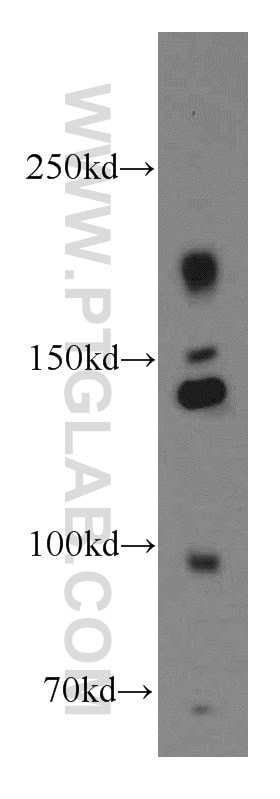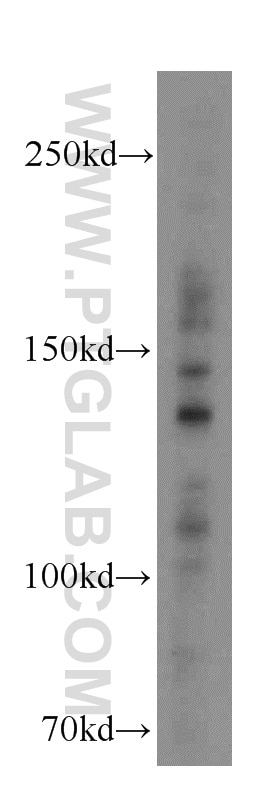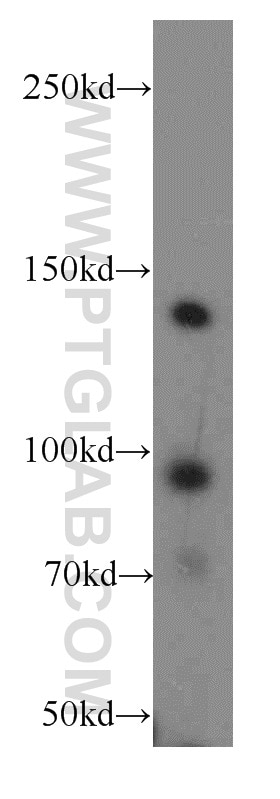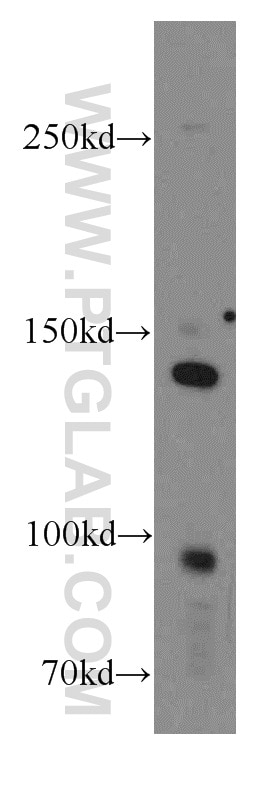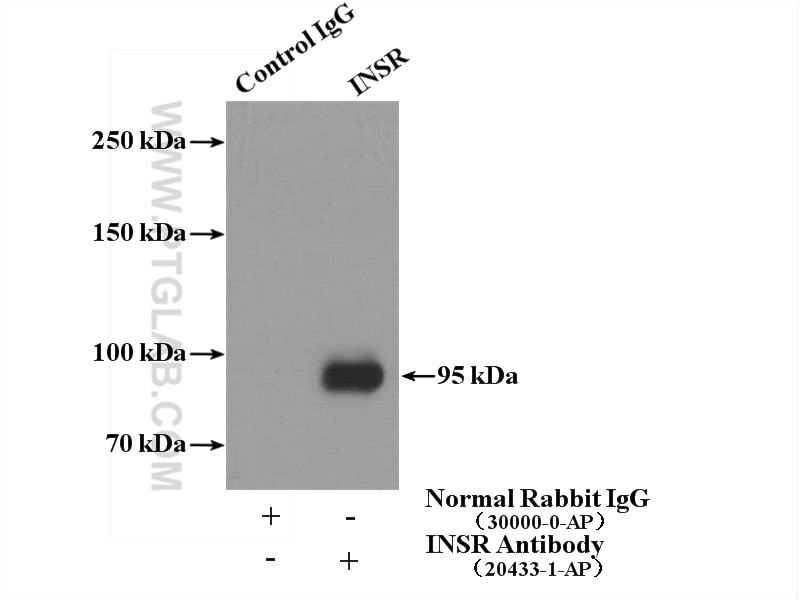Tested Applications
| Positive WB detected in | HEK-293 cells, MCF-7 cells, HT-1080 cells, HeLa cells |
| Positive IP detected in | HeLa cells |
Recommended dilution
| Application | Dilution |
|---|---|
| Western Blot (WB) | WB : 1:500-1:2000 |
| Immunoprecipitation (IP) | IP : 0.5-4.0 ug for 1.0-3.0 mg of total protein lysate |
| It is recommended that this reagent should be titrated in each testing system to obtain optimal results. | |
| Sample-dependent, Check data in validation data gallery. | |
Published Applications
| WB | See 30 publications below |
| IHC | See 1 publications below |
| IF | See 1 publications below |
| CoIP | See 1 publications below |
Product Information
20433-1-AP targets INSR/CD220 in WB, IHC, IF, IP, CoIP, Dot blot, ELISA applications and shows reactivity with human samples.
| Tested Reactivity | human |
| Cited Reactivity | human, mouse, rat, pig, zebrafish, bovine, fish |
| Host / Isotype | Rabbit / IgG |
| Class | Polyclonal |
| Type | Antibody |
| Immunogen |
CatNo: Ag13922 Product name: Recombinant human INSR protein Source: e coli.-derived, PET28a Tag: 6*His Domain: 968-1370 aa of BC117172 Sequence: RKRQPDGPLGPLYASSNPEYLSASDVFPCSVYVPDEWEVSREKITLLRELGQGSFGMVYEGNARDIIKGEAETRVAVKTVNESASLRERIEFLNEASVMKGFTCHHVVRLLGVVSKGQPTLVVMELMAHGDLKSYLRSLRPEAENNPGRPPPTLQEMIQMAAEIADGMAYLNAKKFVHRDLAARNCMVAHDFTVKIGDFGMTRDIYETDYYRKGGKGLLPVRWMAPESLKDGVFTTSSDMWSFGVVLWEITSLAEQPYQGLSNEQVLKFVMDGGYLDQPDNCPERVTDLMRMCWQFNPKMRPTFLEIVNLLKDDLHPSFPEVSFFHSEENKAPESEELEMEFEDMENVPLDRSSHCQREEAGGRDGGSSLGFKRSYEEHIPYTHMNGGKKNGRILTLPRSNPS Predict reactive species |
| Full Name | INSR |
| Calculated Molecular Weight | 1382 aa, 156 kDa |
| Observed Molecular Weight | 190 kDa, 135 kDa, 95 kDa |
| GenBank Accession Number | BC117172 |
| Gene Symbol | INSR |
| Gene ID (NCBI) | 3643 |
| RRID | AB_10646469 |
| Conjugate | Unconjugated |
| Form | Liquid |
| Purification Method | Antigen affinity purification |
| UNIPROT ID | P06213 |
| Storage Buffer | PBS with 0.02% sodium azide and 50% glycerol, pH 7.3. |
| Storage Conditions | Store at -20°C. Stable for one year after shipment. Aliquoting is unnecessary for -20oC storage. 20ul sizes contain 0.1% BSA. |
Background Information
The biological effects of INS are mediated by a membrane-spanning cell surface receptor that has been shown to consist of disulfide-linked alpha-subunits (135 kDa) and beta-subunits (95 kDa) that are cleaved products of a common precursor. The binding of INS to the receptor extracellular domain results in intracellular activation of a tyrosine-specific kinase activity and the generation of signals that determine the cellular response (PMID: 2369896). This antibody raised against 980-1382aa of human INS receptor can recognize full-length INS receptor precursor and INS receptor beta subunit.
Protocols
| Product Specific Protocols | |
|---|---|
| IP protocol for INSR/CD220 antibody 20433-1-AP | Download protocol |
| WB protocol for INSR/CD220 antibody 20433-1-AP | Download protocol |
| Standard Protocols | |
|---|---|
| Click here to view our Standard Protocols |
Publications
| Species | Application | Title |
|---|---|---|
Environ Health Perspect Effects of Chronic Secondhand Smoke (SHS) Exposure on Cognitive Performance and Metabolic Pathways in the Hippocampus of Wild-Type and Human Tau Mice. | ||
Int J Biol Macromol Lycium barbarum polysaccharide mitigates high-fat-diet-induced skeletal muscle atrophy by promoting AMPK/PINK1/Parkin-mediated mitophagy | ||
Food Funct l-Theanine regulates glucose, lipid, and protein metabolism via insulin and AMP-activated protein kinase signaling pathways | ||
Br J Surg MiR-128 regulation of glucose metabolism and cell proliferation in triple-negative breast cancer. | ||
FASEB J Angptl7 promotes insulin resistance and type 2 diabetes mellitus by multiple mechanisms including SOCS3-mediated IRS1 degradation. | ||
Sci Rep NaoXinTong Capsules inhibit the development of diabetic nephropathy in db/db mice. |
Reviews
The reviews below have been submitted by verified Proteintech customers who received an incentive for providing their feedback.
FH Mi (Verified Customer) (05-29-2023) | It works well in human white adipocytes, we get strong signals
|
FH Chiara (Verified Customer) (10-04-2021) | Works well but three bands
|
FH Boyan (Verified Customer) (06-06-2021) | This antibody recognized a band at ~ 180 kd only, which is sensitive to PNGaseF, but not EndoH, treatment. The size is much bigger than an expected InsR band. Importantly, stripping the membrane and re-blot with another InsR antibody from a different brand could detect the protein at the expected MW. These results suggest this InsR antibody is detecting something other than InsR.
|

